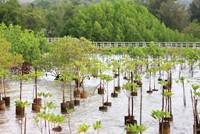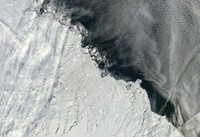Advertisement
Grab your lab coat. Let's get started
Welcome!
Welcome!
Create an account below to get 6 C&EN articles per month, receive newsletters and more - all free.
It seems this is your first time logging in online. Please enter the following information to continue.
As an ACS member you automatically get access to this site. All we need is few more details to create your reading experience.
Not you? Sign in with a different account.
Not you? Sign in with a different account.
ERROR 1
ERROR 1
ERROR 2
ERROR 2
ERROR 2
ERROR 2
ERROR 2
Password and Confirm password must match.
If you have an ACS member number, please enter it here so we can link this account to your membership. (optional)
ERROR 2
ACS values your privacy. By submitting your information, you are gaining access to C&EN and subscribing to our weekly newsletter. We use the information you provide to make your reading experience better, and we will never sell your data to third party members.
Environment
Predicting Climate Change Impacts
Federal Agencies: NSF, DOE, USDA team up to model short-term, regional effects of climate change
by Britt E. Erickson
March 29, 2010

The National Science Foundation and the Departments of Energy and Agriculture have joined forces to fund a research initiative aimed at producing the next-generation computer models for predicting the impacts of climate change on society. The $50 million per year grant program will fund projects that create models that predict climate change effects over shorter time frames and at more localized geographic scales than previously possible.
The program, called the Decadal & Regional Climate Prediction Using Earth System Models, is intended to yield predictions that will help policy makers develop strategies for adapting to climate change at the regional level over the next 10 to 20 years. All three agencies will contribute funding for the program—NSF will provide about $30 million in fiscal 2010, DOE about $10 million, and USDA about $9 million.
All of the program's proposals will be reviewed through NSF's peer review process, but each agency will contribute funds to specific areas. For example "NSF is particularly interested in developing regional and decadal climate predictions that take into account the influences of living systems and predict how living systems will respond and adapt to climate change," NSF director Arden Bement noted at a March 22 briefing to launch the initiative.
DOE is interested in resolving uncertainty associated with the indirect effects of aerosols and clouds, said William F. Brinkman, director of DOE's Office of Science. The agency also wants to predict climate extremes under changing climate and interactions between climate change and natural variability over a few decades.
"We need to move from global models operating on century-long timescales to models that capture regional conditions on the scale of a few decades," Brinkman stressed.
USDA is looking for models that can predict the effects of climate change on the production of food and renewable biofuels, added Roger Beachy, director of USDA's National Institute of Food & Agriculture.
"Climate is an important component of agriculture," Beachy said. "Producers of food will need to know more about what to expect in the future to be ready for the kinds of changes of that are anticipated."
The impacts of climate change "are becoming more profound and immediate than anticipated," Bement noted. Such impacts include "prolonged droughts, increased ecosystem stress, reduced agriculture and forest productivity, altered biological feedbacks, degraded ocean and permafrost habitats, and the rapid retreat of glaciers and sea ice."
"There is strong scientific consensus that climate change is real, is caused by humans, and threatens the wellbeing and prosperity of the people around the world," Brinkman said. "We know we need to act and to act quickly."




Join the conversation
Contact the reporter
Submit a Letter to the Editor for publication
Engage with us on Twitter